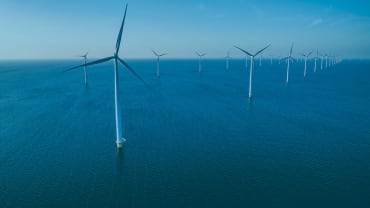Where are the rays of sunlight ?
Amidst all the gloom and criticism surrounding the recent AR5 subsidy round, with no awards for further offshore wind, there are some uplifting rays of sunlight. Not just from the number of awards for solar projects, or the increased support for new onshore wind (see our first article in this series arguing for this), which is welcome).
Also featuring strongly was the tidal power sector. To date this sector has been at a small-scale developmental stage while proven technology is tested in a new environment, but which now seems ready to begin the process of commercialisation.
Outside of the CfD scheme and looking ahead, the hydro power sector, which is based on already proven technology, can itself look forward to the development of a new policy and regulatory framework to support large scale long duration storage. That should enable it to bring forward new projects, and in particular, pumped storage projects, that will contribute to both storage and energy security demands.
The case for tidal power
Scotland owns around 25% of Europe's tidal energy resources. A recent Westminster Environmental Audit Committee report commented that the lack of attention being given to tidal power is a hole in energy strategy. This may be about to change. The new UK energy security strategy suggests that tidal energy technology will be aggressively explored.
There are four tides each day, plus spring and neap tides, which deliver a readily predictable flow year after year. Tidal stream turbines are thought to have a lower environmental impact than alternative solutions such as lagoons or barrages. They use well established technologies, albeit in a new setting.
If fully developed, 11% of UK energy needs could be met from this source. Globally, France, Canada, Japan and China have already recognised the benefits of tidal power. Building on the UK's strong maritime and offshore industrial heritage, there is potential for a high portion of UK content in tidal projects and for tidal expertise to be exported globally.
The AR5 awards
This is the background position of tidal power at the time of AR5. The technology is predictable and reliable but relatively expensive to develop and maintain in the marine environment compared with offshore wind. Risk parameters are still being determined, but in the light of the success of tidal power in AR5 a way must be found to upscale and meet the financing requirements that will be needed to fully deliver these projects.
Tidal power schemes secured contracts in AR5 at a strike price of £198/MWh and with an expectation of projects being delivered in 2027 and 2028. Progress needs to be made in establishing a durable financing model that will enable large scale commercial development.
The steps towards commercialisation
What is needed to achieve this progress? One element is greater success in refining the risk landscape so that there can be movement towards, if not totally achieving, a lower risk benchmark that can begin to attract long-term low-cost finance. This should come partly from the continued success of current projects, the experience of projects in construction, and the collection of verifiable data sufficient to support technical reports.
The setting of CfDs at a realistic level, enabling tidal projects to compete effectively with other technology solutions is another. A further key part is the incentivisation of a local supply chain, whether turbine manufacturing or construction/development expertise. The Scottish Government is attempting to encourage this, but what is needed is evidence of a long-term demand for this expertise, which can only be achieved by a convincing medium term (at the least) UK Government policy.
Opportunities for the financing sector
Another crucial element is a response from the financing sector. There may well be unlimited global liquidity presently available, but it is not available to all. Sources of finance are already diversifying and this trend will need to continue.
The promotion of Green Finance generally is exposing the inadequacy of the three well-established buckets of finance availability – (1) venture capital for start ups, (2) commercial lending and patient equity for growth companies to scale up with IT and other investment, and (3) long term fund lenders to support low risk assets – each having their own time horizons and risk/reward expectations. These models are not responsive enough to current market demand as few of the new opportunities easily fit into one of the buckets. Tidal power production is a good example of where a hybrid medium risk proposition is encountering this funding gap.
So, inevitably, new lending vehicles are emerging. The national development banks are one example of this response, and they have been visibly addressing this issue to some extent, as is the development of export credit agency appetite. There are private sector initiatives as well, including, interestingly, evidence of oil and gas producers looking for green assets. Sovereign wealth funds, too, are expanding their operations. It could be that the tidal power sector is eventually financed by a new breed of lending institution.
UK Government policy commitments
Why should our Governments embrace and encourage this new market? One persuasive reason would be that the predictability of supply delivered by tidal power would support energy security. Another might be that some evidence to date shows that it is easier to develop a more fully local supply chain for these projects. However, presently, there are still barriers to overcome to achieve this, principally the fundamental issue of the enduring certainty of Government policy.
The AR5 auction results supporting 50MW of tidal power indicate that up to £500 million may be required in the next few years for investment in these projects. This is a significant opportunity which we would expect to be responded to by finance markets. A relatively small corner of the UK energy sector may be about to step forward into the mainstream. It clearly does not pack the same punch as the offshore wind sector in terms of scalability, but it can still deliver a valuable lasting contribution to overall energy policy.
Consider also Pumped Storage Hydro Power
There is another technology found in abundance in Scotland that is proven, can be financed, is capable of delivering scale and can contribute to storage solutions and energy security. That is hydro power, and more specifically, pumped storage hydro power which can deliver large scale, long duration storage. This may be delivered through a mix of new build schemes but also the conversion of some existing large scale projects..
The model involves two linked reservoirs, storing water but at different heights. When power is needed, the water flows down from the higher to the lower basin. The water is then pumped back up to the higher basin and stored there until power is needed again. A very simple concept, and using basic established technology, in a mature and reliable form which is used worldwide.
Pumped storage hydro contributes to improved energy security by delivering power as required when the wind doesn't blow and the sun doesn’t shine. It can also provide additional benefit by using power to pump the water back to the higher basin at periods of low demand and high wind and solar generation.
The economic case is convincing
The case for pumped storage hydro has been made forcefully thorough a recent report commissioned by Scottish Renewables from BiGGAR Economics (The Economic Impact of Pumped Storage Hydro), which is worth a read if you've not already seen it.
There are at least six proposed projects in Scotland with developers ready to move to construction planning. They are awaiting only the establishing of a policy and regulatory framework, including the required support mechanisms, which is now promised for 2024. The projects will each have a long life, existing reservoirs have been operating for over 60 years, and there would be limited or no emissions. They would also enable strong local supply chains to be established in rural areas.
The key to financing these projects will be the structure of financial support needed to underpin what may otherwise be unpredictable revenues. A standby power facility would not be able to point to predictability of usage. Management of the demand risk, an issue not unknown in project finance, would be needed. A cap and floor structure is thought possible, with a minimum guaranteed revenue set and with surpluses above the cap being returned to the system operator.
Looking Ahead
If progress is made on policy development for large scale long duration storage in 2024, the first of the planned pumped storage hydro projects could be commissioned for use by 2027, at the same time as the anticipated commissioning of the tidal stream projects supported by AR5. The financing sector therefore needs to be ready to respond soon on what may be a substantial need for capital for deployment. The technology for pumped storage hydro is mature and proven and tidal power technology is the subject of continuing assessment which is near to providing enough comfort for financing.
For both tidal power and pumped storage hydro, as for other solutions necessary to support the energy transition, the settled policy including a route to market and the financial underpinning are crucial elements that UK Government needs to address and deliver on. If they do so, the delivery of both tidal power and pumped storage hydro projects can take us several steps forward this decade in our quest for net zero.













